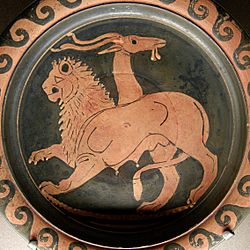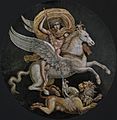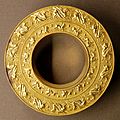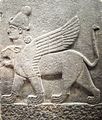Chimera (mythology) facts for kids
Quick facts for kids Chimera |
|
|---|---|

The Chimera on a red-figure Apulian plate, c. 350–340 BC (Musée du Louvre).
|
|
| Abode | Lycia |
| Personal information | |
| Consort | Orthrus |
| Offspring | Nemean Lion, Sphinx |
| Parents | Typhon and Echidna |
| Siblings | Lernaean Hydra, Orthrus, Cerberus |
The Chimera (pronounced Ky-MEER-uh) was a scary, fire-breathing monster from Greek mythology. Its name comes from an Ancient Greek word meaning 'she-goat'.
This creature was a mix of different animals. It had the body of a lion, a goat's head growing from its back, and a snake for a tail. The Chimera was born in a place called Lycia in Asia Minor.
It was the child of two famous monsters, Typhon and Echidna. This made the Chimera a sibling to other well-known beasts like Cerberus, the three-headed dog, and the Lernaean Hydra, a many-headed serpent.
Today, the word "chimera" can describe any creature made of parts from different animals. It can also mean something that is wild, impossible, or just a really imaginative idea.
Contents
Meet the Chimera's Family
The Chimera came from a family of powerful and often scary monsters. Its parents were the giant monster Typhon and the half-woman, half-snake Echidna.
This means the Chimera had some famous monster siblings. These included Cerberus, the guard dog of the Underworld, and the Lernaean Hydra, a serpent with many heads. The Chimera also had monstrous children, like the mighty Nemean lion and the mysterious Sphinx.
What Did the Chimera Look Like?
Ancient Greek writers described the Chimera in detail. The poet Homer wrote that it was "of divine stock not of men." He said it had a lion's body in the front, a serpent (snake) in the back, and a goat in the middle.
Most importantly, the Chimera could breathe out terrible, blazing fire! Other writers like Hesiod and Apollodorus gave similar descriptions. They pictured it as a three-headed creature: a lion's head in front, a fire-breathing goat's head in the middle, and a snake's head for a tail.
The Hero Who Defeated the Chimera
The Chimera was a huge danger to many people. It was known for destroying the countryside and attacking cattle. The people of Lycia were terrified of it.
The hero Bellerophon was given the difficult task of killing the Chimera. The king of Lycia, Iobates, hoped the monster would kill Bellerophon instead. But Bellerophon was brave and had the help of the gods.
He rode his amazing winged horse, Pegasus. Pegasus was a magical horse that had sprung from the blood of the Medusa. Bellerophon soared high into the sky on Pegasus. From above, he was able to shoot down the fire-breathing Chimera and defeat it.
The Chimera in Art
Even though the Chimera lived in a faraway land, it was often shown in Greek art. It appeared early on in Greek pottery paintings. These artworks show some of the first clear mythological scenes in Greek art.
Artists often showed the Chimera with its three animal parts. Sometimes, the goat head would breathe fire, and the tail would be a snake. The story of Bellerophon riding Pegasus and fighting the Chimera was also a popular scene for artists.
Similar Mythical Creatures
The idea of a creature made from different animals is not unique to Greek mythology. Many cultures have similar "hybrid" beasts.
- In Ancient Egypt, there were lioness goddesses like Sekhmet and Bast. They were powerful war deities who could breathe fire.
- The Etruscan civilization (an ancient Italian culture) also had images of the Chimera.
- The Indus civilization in ancient India had pictures of Chimera-like creatures on their seals. These were made from animals found in India.
- In medieval art, "chimerical" figures often showed wild or even evil forces. One example is Geryon from Dante's Inferno. He was a monster with a human face and a scaly tail.
- The Manticore is another creature with a human head, a lion's body, and a scorpion tail.
- The Sphinx is a famous Greek monster with a woman's head, a lion's body, and eagle's wings.
Where Did the Myth Come From?
Some people think the myth of the Chimera might have a real-world origin. Pliny the Elder, an ancient Roman writer, suggested it came from a place in Lycia (modern-day Turkey). This area is called Yanartaş, or "flaming rock."
Here, hikers can still find natural gas vents in the ground. These vents release methane gas that burns constantly. These "eternal fires" were important landmarks in ancient times. Sailors even used them for navigation. It's easy to see how these natural flames could inspire stories of a fire-breathing monster!
Another idea is that the Greek legend came from a Neo-Hittite carving. This carving from Karkemish, made around 850–750 BC, shows a winged lioness with a human head. It's now in the Museum of Anatolian Civilizations.
Images for kids
-
"Chimera of Arezzo": an Etruscan bronze
-
A Roman mosaic of Bellerophon riding Pegasus and slaying the Chimera, 2nd to 3rd centuries AD, Musée de la Romanité
-
A Hellenistic Greek pebble mosaic depicting Bellerophon riding Pegasus while killing the Chimera, Archaeological Museum of Rhodes, dated 300–270 BC
-
Bellerophon riding Pegasus and slaying the Chimera, central medallion of a Roman mosaic from Autun, Musée Rolin, 2nd to 3rd century AD
-
Gold reel, possibly an ear-stud, with a winged Pegasus (outer band) and the Chimera (inner band), Magna Graecia or Etruria, fourth century BC (Louvre)
-
The eternal fires of Chimera in Lycia, modern-day Turkey, where the myth takes place
-
Neo-Hittite Chimera from Karkemish, at the Museum of Anatolian Civilizations
See also
 In Spanish: Quimera (mitología) para niños
In Spanish: Quimera (mitología) para niños
- Grotesque (architecture)
- Anzû (older reading: Zû), a Mesopotamian monster
- The Beast in Christianity eschatology
- Chimera of Arezzo
- Chimaera, genus of fish named after the mythical creature
- Dābbat al-Arḍ in Islamic eschatology
- Dragon, a reptilian monster sharing similar hybrid, flying and fire-breathing traits
- Garuda, a mythical creature and Demigod from Indian sub-continent
- Griffin a.k.a. griffon or gryphon, a lion/eagle hybrid
- Hybrid creatures in mythology
- Kotobuki, a Japanese Chimera with the parts of the animals on the Chinese Zodiac.
- Lamassu, an Assyrian deity described to be bull/lion/eagle/human hybrid
- List of hybrid creatures in folklore
- Manticore, a mythical creature with a human head, a lion body, a scorpion tail, spines like a porcupine, and bat wings in some iterations
- Nue, a Japanese Chimera with the head of a monkey, the body of a tanuki, the legs of a tiger, and a snake-headed tail
- Pegasus, a winged stallion in Greek mythology
- Pixiu or Pi Yao, Chinese mythical creature
- Snallygaster, a mythical creature with metal beak, reptilian body, bird-like wings and octopus tentacles
- Sphinx, a mythical creature with a woman's head, lion's body and eagle's wings
- Simurgh, an Iranian mythical flying creature
- Ziz, a giant griffin-like bird in Jewish mythology









